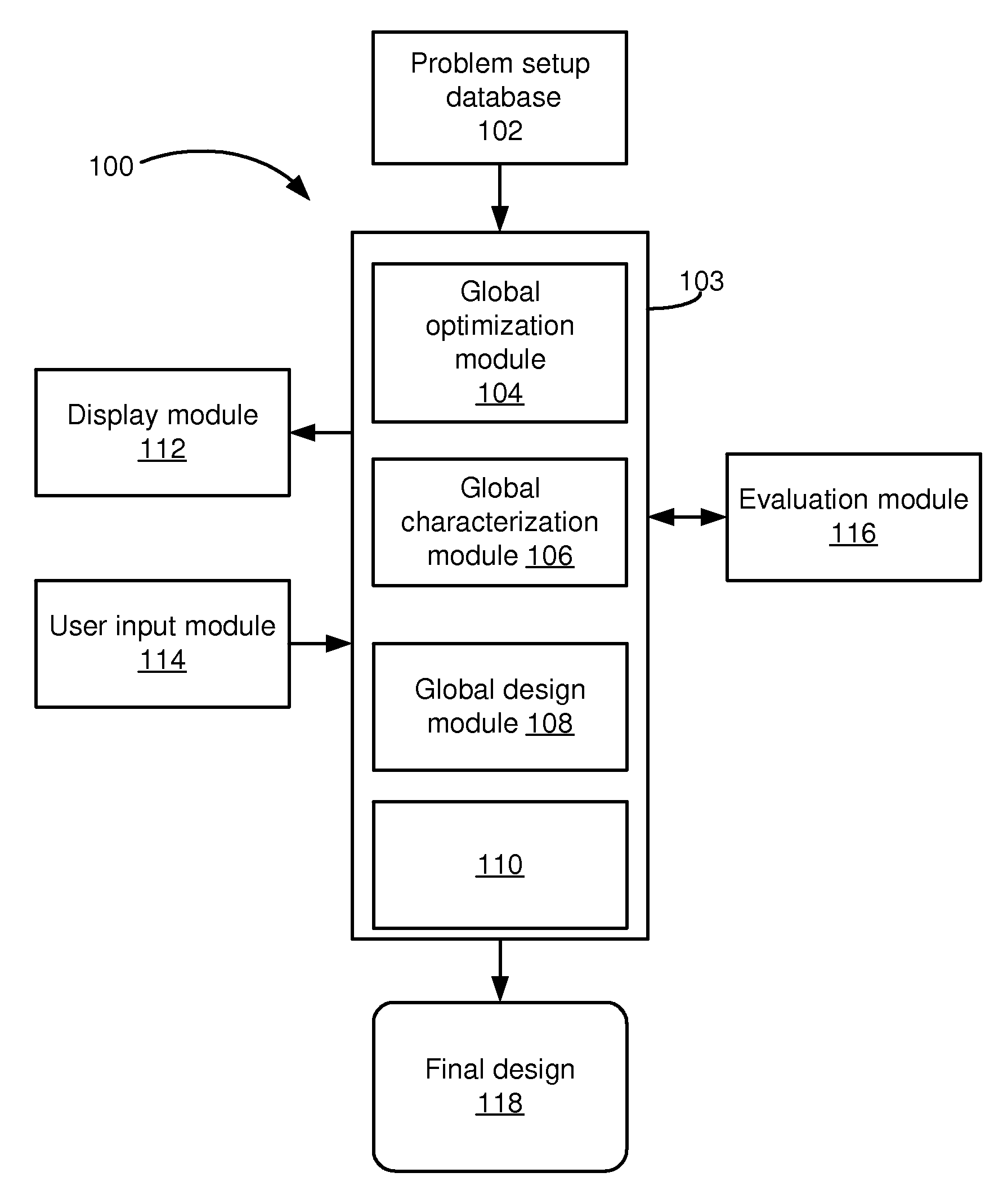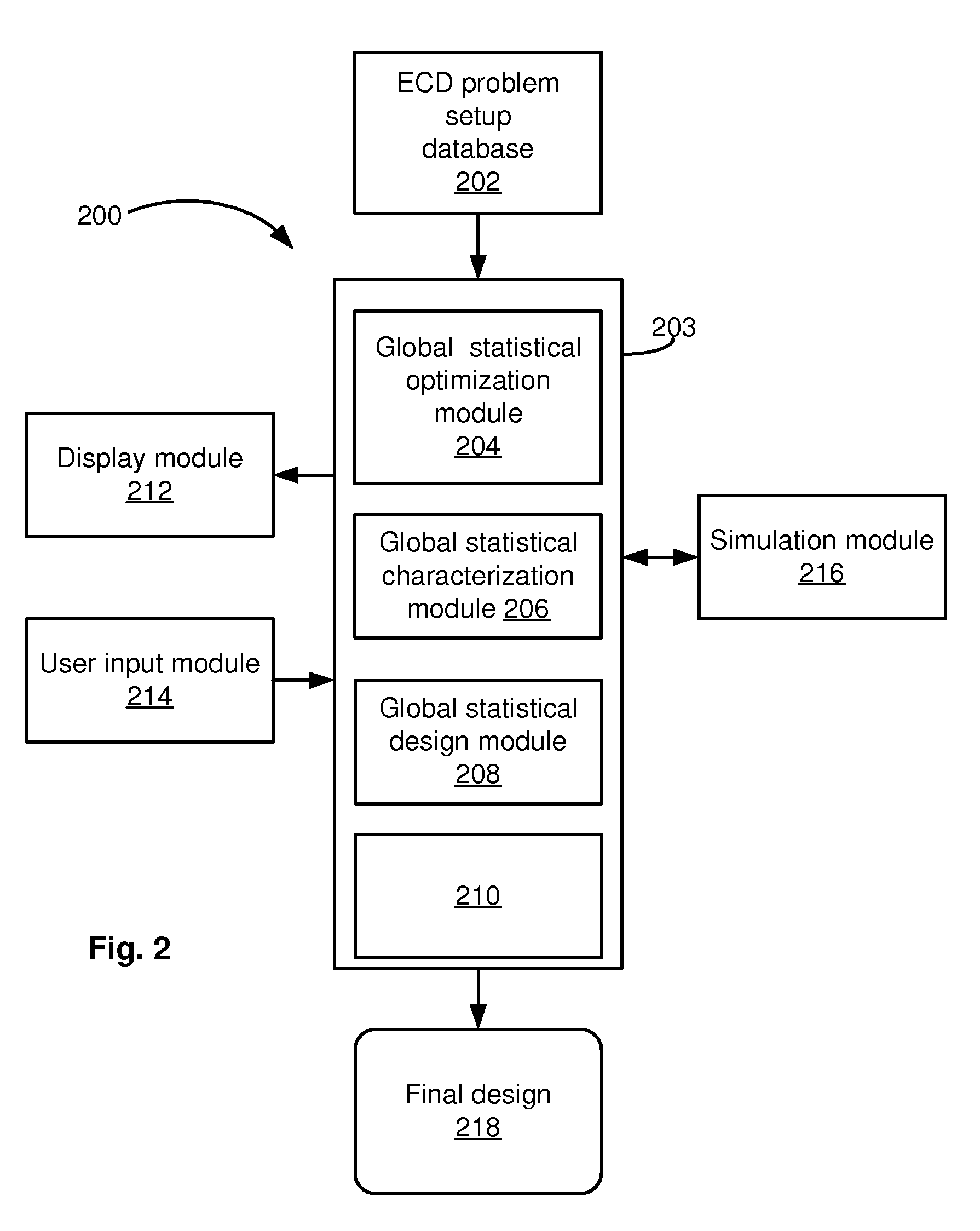However, the design problem is hard to decompose into simpler problems because the variables often have nonlinear interactions.
All these variables impede a designer's ability to understand the issues affecting yield early in the design stage, and therefore his ability to choose device sizes that maximize yield.
Optimization of ECDs can be challenging.
This hinders the applicability of yield optimization using naïve Monte Carlo sampling (e.g., where the optimizer's cost function is −1.0*yield) because it would allow only a highly limited number of candidate designs to actually be examined within a reasonable time period.
There are other challenges too: the cost function is generally a blackbox, which means that it is possibly nonconvex, possibly non-differentiable (and without easy access to derivatives), and possibly non-continuous.
Such characteristics preclude the use of existing optimization algorithms that could otherwise take advantage of those properties.
In other word, it is not possible to use algorithms that exploit numerous simplifying assumptions.
Similarly problems in yield optimization, or robust design, or stochastic optimization, exist in many technical fields beyond that of ECDs.
In fact, such problems exist in almost any engineering field in which parameterizable design problems exist, for which simplifying assumptions cannot be made, and which have means of estimating a design's cost functions such as with a dynamical systems simulator.
There is no approach that can do full global yield optimization on hundreds of variables with no simplifying assumptions.
However, a major issue is that variable interactions are not captured.
This can be a problem since interaction between design variables often matter in circuit design (i.e., circuit design problems are not linearly separable).
However, if there are N variables then there would be an order N2 interactions to simulate on a grid and plot, which can be prohibitively expensive.
For example, 5 values per variable would imply 25 samples (probably reasonable) for each two-variable interaction but is not enough resolution to be interesting, but a higher resolution of 10 samples per variable means 100 samples (probably unreasonable) for each two-variable interaction.
However, the approach performs abysmally when the number of design variables is large and the range of each design variable is large.
That is, the regression models capture the true mapping poorly because the mapping is highly nonlinear.
More training samples are limited in the help they can provide because simulation time is not negligible.
Unfortunately, these approaches introduce massive overhead in continual rebuilding of models, and the final models are often inaccurate.
Finally, it is unclear how to incorporate statistical awareness into these characterization approaches in a general way.
For example, for model-building approaches, adding process variables can imply a ten-time increase in the number of variables, which can be prohibitive when the number of input variables for a model has a strong impact on its ability to predict.
The challenge that remains for characterization of MPD's, and ECD's in particular, is to capture and display mappings from design variables to performance, across the whole design space (where there can be hundreds of design variables), in reasonable time (e.g., in less than one day), in reasonable number of simulations (e.g., in less than 100,000 simulations), and including capturing design variable interactions, and other possible nonlinearities.
Such circuit design environments have issues because the user cannot quickly get insight into the whole design at once.
There is also the risk of obtaining candidate designs for local optima during design because the user may inadvertently focus on locally optimal regions, not knowing that better design regions of design variables space.
In sum, current design environments' functionality for trying new designs has feedback, and the feedback offered is partial at best, causing inefficient and possibly suboptimal design.
Especially in the smallest blocks (also referred to as sub-blocks), designers find themselves spending considerable time finding the right sizes for the design, despite having designed such blocks possibly dozens or even hundreds of times before.
The reason they keep redesigning these smallest blocks is that there can be slight variations in the ECD design problem.
As such, continually redesigning such trivial circuits takes time, which could be better spent on more challenging design tasks if there were a means to design such sub-blocks more quickly.
Optimizers can be used but the designer typically doesn't know exactly what specifications they want for each tiny block, and there is a tradeoff that can be explored before the user knows what he wants.
Additionally, setting up an optimization (single- or multi-objective) can be more time-consuming than it would take the designer to just size the block or sub-block manually.
 Login to View More
Login to View More  Login to View More
Login to View More 


